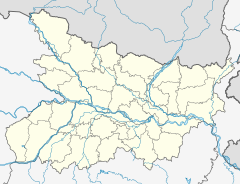A gurdwara is a place of assembly and worship for Sikhs. Sikhs also refer to gurdwaras as Gurdwara Sahib. People from all faiths are welcomed in gurdwaras. Each gurdwara has a Darbar Sahib where the Guru Granth Sahib is placed on a takhat in a prominent central position. Any congregant may recite, sing, and explain the verses from the Guru Granth Sahib, in the presence of the rest of the congregation.

The Guru Granth Sahib is the central holy religious scripture of Sikhism, regarded by Sikhs as the final, sovereign and eternal Guru following the lineage of the ten human gurus of the religion. The Adi Granth, its first rendition, was compiled by the fifth guru, Guru Arjan (1564–1606). Its compilation was completed on 29 August 1604 and first installed inside Golden Temple in Amritsar on 1 September 1604. Baba Buddha was appointed the first Granthi of the Golden Temple. Shortly afterwards Guru Hargobind added Ramkali Ki Vaar. Later, Guru Gobind Singh, the tenth Sikh guru, added hymns of Guru Tegh Bahadur to the Adi Granth and affirmed the text as his successor. This second rendition became known as the Guru Granth Sahib and is also sometimes referred to as the Adi Granth.

The Dasam Granth is a collection of various manuscripts in Sikhism containing compositions attributed to Guru Gobind Singh. Guru Gobind Singh ordained the sacred text Guru Granth Sahib as his successor, eternally ending the line of human Gurus. It is the primary holy scripture of the Sikhs and regarded by Sikhs as the living embodiment of Ten Gurus. Bachittar Natak is a part of composition

Anandpur Sahib, sometimes referred to simply as Anandpur, is a city in Rupnagar district (Ropar), on the edge of Shivalik Hills, in the Indian state of Punjab. Located near the Sutlej River, the city is one of the most sacred places in Sikhism, being the place where the last two Sikh Gurus, Guru Tegh Bahadur and Guru Gobind Singh, lived. It is also the place where Guru Gobind Singh founded the Khalsa Panth in 1699. The city is home to Takhat Sri Kesgarh Sahib, Third of the five Takhts in Sikhism.

The Takht Sri Darbar Sahib Damdama Sahib, is one of the five takhts or Seat of Temporal Authority of Sikhism, located in Talwandi Sabo in Punjab, India. At this place Guru Gobind Singh, the tenth Sikh Guru, prepared the full version of the Sikh scriptures called Sri Guru Granth Sahib in 1705. The other four Takhts are the Akal Takht, Takht Sri Keshgarh Sahib, Takht Sri Patna Sahib and Takht Sri Hazur Sahib.
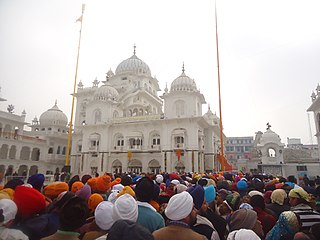
Takht Sri Patna Sahib also known as Takhat Sri Harimandir Ji, Patna Sahib, is one of the five takhts of the Sikhs, located in Patna, Bihar, India. The construction of the takht was commissioned by Maharaja Ranjit Singh in the 18th century to mark the birthplace of Guru Gobind Singh. Due to the damage caused by an earthquake in 1934, the building was rebuilt between 1948 and 1957 for ₹20,00,000. The current acting jathedar of Takht Patna Sahib is Baldev Singh, who was appointed by Harpreet Singh, the acting jathedar of the Akal Takht on 2 December 2022.

The principal Sikh scripture is the Adi Granth, more commonly called the Guru Granth Sahib. The second most important scripture of the Sikhs is the Dasam Granth. Both of these consist of text which was written or authorised by the Sikh Gurus.
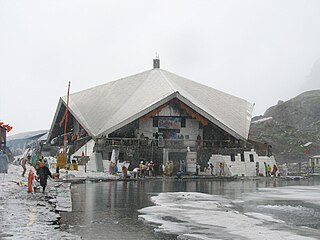
Hemkund Sahib, formally known as Gurudwara Shri Hemkund Sahib Ji, is a Sikh place of worship and pilgrimage site in Chamoli district, Uttarakhand, India. It is devoted to Guru Gobind Singh (1666–1708), the tenth Sikh Guru, and finds mention in Dasam Granth. With its setting of a glacial lake surrounded by seven mountain peaks, each adorned by a Nishan Sahib on its cliff, it is according to the Survey of India located in the Garhwal Himalaya at an elevation of 4,160 meters. It is approached from Govindghat on the Rishikesh-Badrinath highway. The main town near Gobindghat is Joshimath. The elevation of the lake at Hemkund is approximately 13,650 feet.
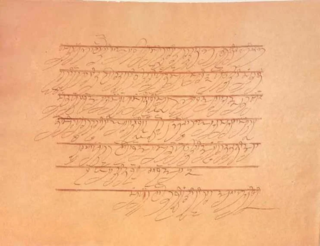
Chandi Di Var is a composition written by Guru Gobind Singh, included in the 5th chapter of Dasam Granth. It is based on an episode from the Sanskrit work Markandeya Purana, and describes the conflict between the Gods and the Demons. In the ballad, the supreme goddess is transformed into a liberating divine power in the form of sword, that crushes perpetuators of falsehood.
A Hukamnama, in modern-times, refers to a hymn from the Guru Granth Sahib which is given as an injunction, order, or edict to Sikhs. It also refers to edicts issued by the contemporary Takhts. In the historical sense, it was used to refer to an issued injunction, order, or edict given by one of the Gurus of Sikhism or their officiated followers and associates during their lives.
Gurdwara Sri Guru Gobind Singh Ghat, also known as Gurudwara Kangan Ghat, is a Sikh place of worship on the banks of the Ganges River approximately 650 m (710 yd) from Takht Sri Patna Sahib. In sikh historical sources, this is the place where Guru Gobind Singh threw his gold bangle (kangan) and passed on the knowledge of Sri Guru Granth Sahib Ji to Pandit Shiv Dutt, a devotee of Sri Ram Chandra.
Gurdwara Bal Lila Maini Sangat in a narrow lane close to Takht Sri Harmandir Sahib marks the house where King Fateh Chand Maini lived. His childless Queen had developed special fondness for the young Guru Gobind Singh, who, too, often came here to sit in the Queen's lap giving her immense delight and spiritual solace. She fed the Child Gobind and his playmates, at his demand, with boiled and salted gram. Even now boiled and salted gram is served as prasad in this Gurdwara, which, unlike the other shrines in Patna Sahib, is served by Nirmala Sikhs. A wood carving on the old front door is dated 28 August 1668, but the hall housing the sanctum and other blocks of rooms in the inner compound have been reconstructed during recent decades.
About three kilometers east of Takht Sri Harmandir Sahib is where Guru Tegh Bahadur first alighted in a garden (bagh) belonging to Nawabs Rahim Bakhsh and Karim Bakhsh, nobles of Patna, and where the sangat of Patna along with the young Guru Gobind Singh came out to receive him back from his four-year-long odyssey. A shrine commemorative of the first meeting of Tegh Bahadur and Gobind Singh was established here. Its present building was constructed during the 1970s and 1980s. An old well which is still in use and a dried stump of the Imli tree under which the sangat met Guru Tegh Bahadur still exists.
Hinduism is the most followed religion in Bihar, followed by nearly 82.7% of total population as per 2011 Census. Islam is the second-most followed religion which is followed by nearly 16.8% of population. There is also a significant population of Jains and Christians in the state.
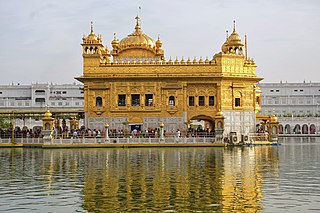
The Golden Temple is a gurdwara located in the city of Amritsar, Punjab, India. It is the preeminent spiritual site of Sikhism. It is one of the holiest sites in Sikhism, alongside the Gurdwara Darbar Sahib Kartarpur in Kartarpur, and Gurdwara Janam Asthan in Nankana Sahib.

Hazur Sahib, also known as Takht Sachkhand Sri Hazur Abchalnagar Sahib, is one of the five takhts in Sikhism. The gurdwara was built between 1832 and 1837 by Maharaja Ranjit Singh (1780–1839). It is located on the banks of the Godavari River at the city of Nanded in the state of Maharashtra, India.
A takht, or taḵẖata, literally means a throne or seat of authority and is a spiritual and temporal centre of Sikhism. There are five takhts, which are five gurudwaras that have a very special significance for the Sikh community. Three are located in Punjab whilst the remaining two are located outside of it.
Prakash Punj or Bahu Uddeshiya Prakash Kendra and Udyan is under construction park at Guru Ka Bag near Bazzar samiti in Patna Sahib area.
Gurdwara Guru Singh Sabha, Kedli Kalan, is one of the oldest gurdwara of Eastern India.
